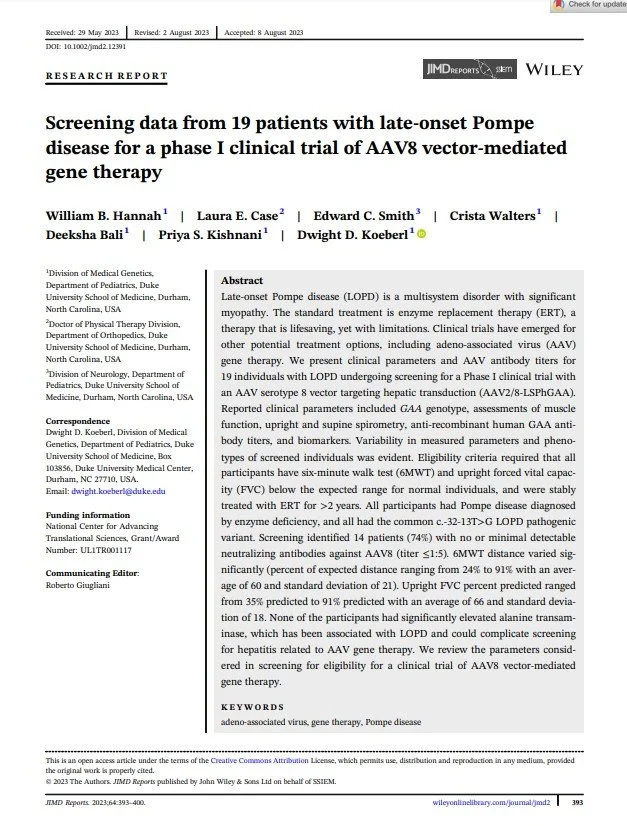
Media
EVENTS
PUBLICATIONS
Pamrevlumab, a Fully Human Monoclonal Antibody Targeting Connective Tissue Growth Factor, for Non-Ambulatory Patients with Duchenne Muscular Dystrophy
This Phase II, single-arm trial assessed intravenous infusions of pamrevlumab in 15 non-ambulatory patients for 2 years. The treatment is a fully human monoclonal antibody binding to connective tissue growth factor (CTGF). Results from this study found the rate of muscle function decline was slower in treated versus non-treated patients. This anti-GTGF therapy represents a potential treatment for DMD.
Multi-Laboratory Evaluation of Prototype Dried Blood Spot Quality Control Materials for Creatine Kinase-MM Newborn Screening Assays
The Newborn Screening Quality Assurance Program (NSQAP) at the U.S. Centers for Disease Control and Prevention (CDC) produced a set of seven prototype dried blood spot (DBS) reference materials spiked with varying levels of creatine kinase MM isoform (CK-MM). These DBS were evaluated over a 3-week period by CDC, NYS, and RTI, all using the same CK-MM isoformspecific fluoroimmunoassay.
A Randomized, Double-Blind, Placebo-Controlled, Global Phase 3 Study of Edasalonexent in Pediatric Patients with Duchenne Muscular Dystrophy: Results of the PolarisDMD Trial
This international, randomized 2 : 1, placebo-controlled, phase 3 study in patients ≥ 4–<8 years old with DMD due to any dystrophin mutation examined the effect of edasalonexent (100 mg/kg/day) compared to placebo over 52weeks.
MDA 2022 Conference Presentation: Phase 2 Multiple-Ascending-Dose Study of SRP-5051 PPMO in Patients with DMD Amenable to Exon 51 Skipping: Part A Results
SRP-5051 is an investigational PPMO designed to skip exon 51 of the DMD gene to restore the reading frame and allow production of internally truncated dystrophin
Association of Genetic Mutations and Loss of Ambulation in Childhood-Onset Dystrophinopathy
Quantifying associations between genetic mutations and loss of ambulation (LoA) among males diagnosed with childhood-onset dystrophinopathy is important for understanding variation in disease progression and may be useful in clinical trial design.
MDA Conference Poster: Measuring Habitual Physical Activity in Duchenne Muscular Dystrophy
This is a study of the habitual physical activity of DMD patients at different stages of disease progression using actigraphy.
ACMG 2022 Conference Poster: Phase 2 Multiple Ascending-Dose Study of SRP-5051 PPMO in Patients with DMD Amenable to Exon 51 Skipping: Part A Results
A Phase 2, open-label, non-randomized, two-part dose determination and expansion study of SRP-5051 in patients with DMD.
Corticosteroids have been shown to improve muscle strength and delay loss of ambulation (LOA) in Duchenne muscular dystrophy (DMD) and are considered standard of care despite significant side-effects. The objective of this study is to evaluate whether corticosteroid treatment after LOA is beneficial for cardiac or pulmonary functions among boys with DMD.
Evaluation of effects of continued corticosteroid treatment on cardiac and pulmonary function in non-ambulatory males with Duchenne muscular dystrophy from MD STARnet
The objective of collaborative studies, such as partnering Children’s Healthcare of Atlanta, Emory University, and Rare Disease Research is to examine the prevalence of diagnoses and health disparities in our community. A study to analyze the number of boys with Duchenne muscular dystrophy (DMD) in the Atlanta area found race differences when identifying children testing positive for anti-AAV types 2 and 9Nab.
Prevalence of Anti-AAV Types 2 and 9Nab titers in Atlanta’s DMD Community
Efficacy and Safety of Vamoralone over 48 weeks in Boys with Duchenne Muscular Dystrophy
This randomized, double-blind, placebo-controlled and prednisone-controlled clinical trial was conducted to determine the efficacy and safety of vamoroline over 48 weeks and to study crossover participants.
Two years of newborm screening for Duchenne muscular dystrophy as a part of the statewide Early Check research program in North Carolina
A prosepctive study conducted in anticipation of the nomination of Duchenne Muscular Dystrophy for universal newborn screening.
Age-Related Blood Levels of Creatinine Kinase-MM in Newborns and Patients with Duchenne Muscular Dystrophy: Considerations for the Development of Newborn Screening Algorithms
Duchenne muscular dystrophy (DMD) is an X-linked progressive disorder and the most common type of muscular dystrophy in children. The objective of this study is investigate the relationship between age adn CK-MM in presumed healthy newborns to inform NBS algorithm designs.
Findings from the Longitudinal CINRG Becker Natural History Study
A 3-year, longitudinal, prospective dataset contributed by a cohort of 83 patients with confirmed Becker muscular dystrophy, ages 5-75 years at baseline, were analyzed to characterize the natural history of this disorder. A better understanding of the natural history is crucial to rigorous therapeutic trials.
Reanalysis of RNA sequencing data ends diagnostic odyssey and expands the phenotypic spectrum of congenial titinopathy
The objective of this case is to highlight the importance of reanalyzing genetic data and considering known variants to avoid delays in diagnosis.
Parental perspective of the episodic irritability in an ultra-rare genetic disorder associated with NACC1
This trial shows that a specific genetic change, NECFM caused by the recurrent variant c.982C>T, leads to episodes of severe irritability that is still not fully understood. Learning more about how this genetic change affects the body could help develop better treatments.
The severity of MUSK pathogenic variants is predicted by the protein domain they disrupt
This report outlines a case of neonatal-onset MUSK-related CMS in a patient harboring compound heterozygous deletions in the MUSK gene, including: a deletion of exons 2-3 leading to an in-frame MUSK protein lacking the immunogloubin domain, and a deletion of exons 7-11 leading to out-of-frame, truncated MUSK protein.
Reanalysis of clinical exome identifies the second variant in two individuals with recessive disorders
Clinical and exome/ genome sequencing is increasingly being utilized by clinicians to diagnose various likely genetic conditions, but many remain undiagnosed. Here, two cases were described where a second where a second variant was found upon reanalysis of the exome data. A review of existing literature shows that this reanalysis step is often missed. This report reviews the importance of reanalyzing data in undiagnosed cases where upon initial testing, only one variant was found.
Efficacy and Safety of Viltolarsen in Boys With Duchenne Muscular Dystrophy: Results from the Phase 2, Open-Label, 4- Year Extension Study
This phase 2, open-label, 192-week, long-term extension study evaluated the efficacy and safety of viltolarsen in participants aged 4 to <10 years at baseline with DMD amenable to exon 53 skipping. The results of this 4-year long-term extension show that vitolarsen can be an important treatment strategy for DMD patients amenable to exon 53 skipping.
Screening data from 19 patients with late-onset Pompe disease for a phase 1 clinical trial of AAV8 vector-mediated gene therapy
Screening data for a LOPD gene therapy trial provide insight into important considerations for enrollment criteria and serveillance of possible hepatitis. Among patients with LOPD screened for a phase I AAV gene therapy trial. 74% had no or minimal detectable pre-existing antibodies to the AAV vector.
Biallelic variants in ribonuclease inhibitor (RNH1), an inflammasome modulator, are associated with a distinctive subtype of acute, necrotizing encephalopathy
The aim of this study is to evaluate clinical data, neuroradiological studies, genomic sequencing, and protein immunoblotting results in 8 children from 4 familieswho experienced acute febrile encephalopathy. Gemonic sequencing in children with unexplained acute febrile encephalopathy can detect underlying genetic etiologies, such as RNH1, and improve outcomes in the affected and at-risk siblings.
Phase 1 study of liver depot gene therapy in late-onset Pompe disease
This 52-week open-label, single-dose, dose-escalating study was designed to objectively assess the safety and bioactivity of ACTUS-101 in subjects diagnosed with Pompe disease, which is caused by a defect in GAA gene. ACTUS is intended to enable expression of a functional copy of the GAA gene in subjects hepatocytes.

Contact Us
Still have questions? Please don’t hesitate to drop us a note or a schedule a call.






















